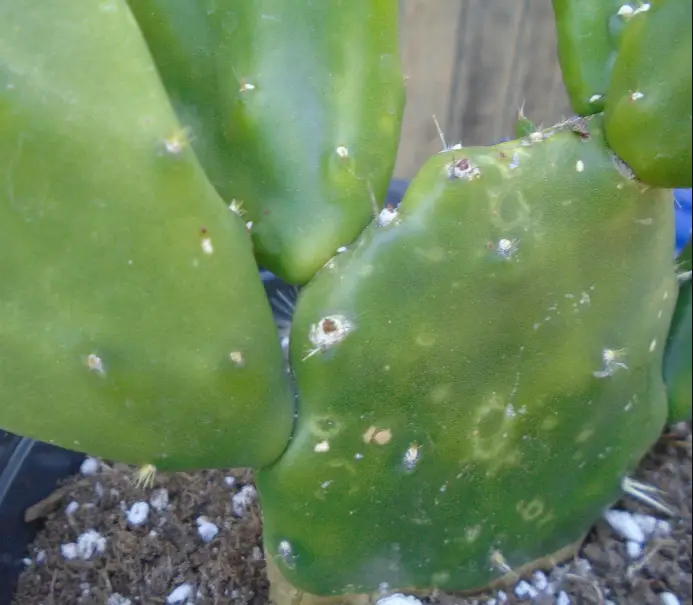As a prickly pear cactus owner, you may notice white spots appearing on the pads of your plant. These spots can be alarming and raise concerns about the health of your cactus. However, with the right information, you can identify the cause of the white spots and take action to resolve the issue. In this article, we’ll explore the main causes of white spots on prickly pear cactus and provide solutions to restore your plant’s health.
What Causes White Spots on Prickly Pear Cactus?
There are several potential culprits that can lead to white spots on prickly pear pads. Here are the most common causes:
-
Pest Infestations Insects like mealybugs, soft scale, and cochineal scale attach themselves to cacti and secrete white wax that appears as spots. They damage plants by sucking juices.
-
Sunscald Exposure to intense sunlight can burn tender tissue and cause white sunscald spots It often affects newly transplanted cacti
-
Fungal Diseases Powdery mildew is a fungal disease that manifests as a white powdery coating on cacti High humidity encourages its growth.
-
Nutrient Deficiencies: Lack of key nutrients like nitrogen, phosphorus, and magnesium leads to stunted growth and white spots.
-
Mineral Buildup: Accumulation of salts and minerals from hard water or overfertilizing causes white mineral crusts.
-
Physical Damage: Knocks, scrapes, frost damage, and other physical injuries leave white scars on prickly pear pads.
Accurately identifying the cause of the spots is crucial before attempting treatment. Examine your cactus closely and consider recent care to pinpoint the culprit.
How to Get Rid of White Spots on Prickly Pear Cactus
Once you know the source of the spots, take appropriate corrective measures:
For Pests:
-
Wash away insects with a strong stream of water or use a soft brush.
-
Apply insecticidal soap or neem oil sprays targeting the specific pest. Follow label directions.
-
Use a cotton swab dipped in rubbing alcohol to spot treat scale bugs.
For Sunscald:
-
Move the cactus to a shadier location with indirect sunlight.
-
Mist the affected pads with water to soothe burns and prevent additional damage.
For Fungal Diseases:
-
Improve air circulation and isolate infected plants to prevent spreading.
-
Apply fungicides made for powdery mildew on cacti. Severely damaged parts may need removal.
For Nutrient Deficiencies:
-
Fertilize with a balanced, water-soluble cacti fertilizer during growing season.
-
Repot in fresh cactus soil to replenish nutrients if potbound.
For Mineral Buildup:
-
Flush soil periodically by thoroughly watering to wash away excess salts and minerals.
-
Switch to filtered or distilled water for watering to prevent further accumulation.
For Physical Damage:
-
Gently wipe scars with a damp cloth to clean and prevent infection.
-
Protect sensitive new growth from potential physical harm.
Prevention Tips to Avoid White Spots
While treating current white spots, also take preventative steps to avoid recurrence:
-
Situate prickly pear cacti in locations with optimal sunlight exposure for the species. Gradually acclimate new plants.
-
Practice proper watering technique. Allow soil to dry between thorough soakings and avoid overhead watering.
-
Provide good air circulation and give each cactus adequate spacing.
-
Use well-draining cactus soil and containers with drainage holes.
-
Fertilize lightly to avoid mineral buildup. Flush soil every few months.
-
Monitor for pests routinely and take quick action at first signs. Focus on prevention.
-
Handle prickly pear carefully during repotting and transportation to prevent physical damage.
When to Seek Professional Help
In most cases, white spots can be managed with attentive home care. However, if the spots rapidly worsen or any of the following occur, enlist professional help:
-
Spots spread to take over most of the cactus.
-
You observe signs of rot like mushy spots.
-
The cactus shows stunted growth or declined vigor.
-
Pest problems persist after multiple treatment attempts.
-
You are unsure of the cause of the white spots.
A cacti specialist can accurately diagnose stubborn issues and provide prescription solutions. Don’t delay reaching out for help if DIY efforts fail.
Maintain Your Cactus’ Health
Catching and resolving white spots early preserves your prickly pear cactus’ beauty and vitality. Any time you notice questionable spots, take a close look and make a plan of action based on the cause. With appropriate solutions, you can get your beloved cactus back to its unblemished, photosynthesizing self. Consistent care focused on prevention will help deter recurring issues. Keep your eyes peeled and enjoy your prickly friend for years to come.

Scale on Prickle Pear Cactus
FAQ
How do you get rid of cochineal on prickly pear cactus?
Malathion and triazide combined with Neem oil or Volck dormant oil spray should do the trick. Apply according to the manufacturer’s directions.Dec 6, 2022
What are all the white dots on the cactus?
Mealybugs are the most common pest that can cause white spots on your succulents since the bugs themselves look like cottony spots that gather on the underside of your succulent’s leaves.
Why has my cactus got white stuff on it?
… cacti, like the Peruvian old man (Espostoa lanata) and Peruvian old lady (Espostoa melanostele), are normal, healthy modified tissues, not an insect product
What is the fungal infection on prickly pear cactus?
Scorch or Sunscald (fungus – Hendersonia opuntiae): This disease is common and serious on prickly pear cactus (Opuntia). Spots at first are distinctly zoned, later enlarging until entire cladodes turn a reddish-brown and finally die. The center of the disease area is grayish-brown and cracked.
